Red Line Gear Oil Technical Information
Presented by Jeff Lucius
The information and figures below are directly from Red Line's printed material and all rights are reserved by them. I present this information solely for educational purposes.
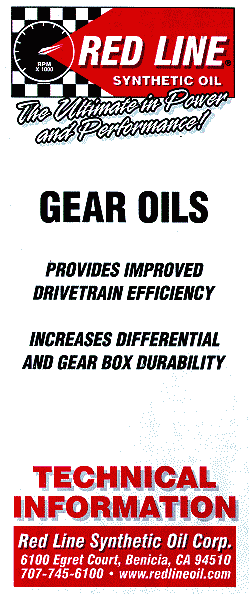 RED LINE SYNTHETIC GEAR OILS are designed to provide the highest degree of protection and greatest efficiency for your drivetrain. Red Line provides a com- plete line of drivetrain lubricants which are optimized for differential, transmission, or transaxle use over a wide range of temperatures. Proper selection depends upon the manufacturers' requirements and whether the application is for passenger automotive, commercial, or racing use. Red Line Gear Oils contain polyol ester base stocks, the only lubricants which can withstand the tremendous heat of modern jet engines, which makes our products provide excellent lubrication even under extreme conditions of high-loading and high-temperatures. The natural lubricity of the polyol esters provide excellent slipperiness which reduces the sliding friction in hypoid gears - reducing wear and significantly reducing temperatures. The synthetic basestocks have a natural multigrade property, so large amounts of unstable thickeners are not required to manufacture our gear oils, which means that Red Line Gear Oils will provide a stable viscosity for even extended periods of use. Red Line formulates more extreme-pressure protection into the gear oils than other petroleum and synthetic manufacturers which provides wear protection over a wider range of temperatures and performance conditions - ranging from high-torque and low-speed situations to very high-speed conditions with shock loading. Red Line also manufactures gear oils which can be used in limited-slip differentials without the use of additional friction modifiers.
RED LINE SYNTHETIC GEAR OILS are designed to provide the highest degree of protection and greatest efficiency for your drivetrain. Red Line provides a com- plete line of drivetrain lubricants which are optimized for differential, transmission, or transaxle use over a wide range of temperatures. Proper selection depends upon the manufacturers' requirements and whether the application is for passenger automotive, commercial, or racing use. Red Line Gear Oils contain polyol ester base stocks, the only lubricants which can withstand the tremendous heat of modern jet engines, which makes our products provide excellent lubrication even under extreme conditions of high-loading and high-temperatures. The natural lubricity of the polyol esters provide excellent slipperiness which reduces the sliding friction in hypoid gears - reducing wear and significantly reducing temperatures. The synthetic basestocks have a natural multigrade property, so large amounts of unstable thickeners are not required to manufacture our gear oils, which means that Red Line Gear Oils will provide a stable viscosity for even extended periods of use. Red Line formulates more extreme-pressure protection into the gear oils than other petroleum and synthetic manufacturers which provides wear protection over a wider range of temperatures and performance conditions - ranging from high-torque and low-speed situations to very high-speed conditions with shock loading. Red Line also manufactures gear oils which can be used in limited-slip differentials without the use of additional friction modifiers.
BENEFIT SUMMARY
- Provides the greatest gear protection available
- Reduces differential and gearbox temperatures
- Increases differential and gearbox durability
- Rapid lubrication even in very cold weather
- Improves shifting in manual transmissions
- Provides improved drivetrain efficiency
- Prevents foaming even at high speeds
- Low corrosiveness reduces synchronizer wear
- Stable even at elevated temperatures
- Can be used in limited-slip and regular differentials
- Suitable for competition and street use
- Compatible with petroleum and other synthetics
- Compatible with seals designed for petroleum
- Satisfies requirements calling for API GL-5 and GL-6
- Allows extended drains in non-warranty vehicles
IMPROVED GEAR PROTECTION
Proper differential and transmission lubrication requires a product which will satisfy a wide range of service conditions. The off-set gear intersection design in hypoid differentials requires a high degree of extreme pressure chemistry to prevent scoring of the ring and pinion set under high-speed conditions and spalling under low-speed / high-torque conditions. High temperatures can cause a breakdown of the petroleum, forming insoluble sludge which can plug the bearing cages and cause oil starvation to the bearing surfaces. Limited-slip clutches require additional slipperiness compared to conventional hypoid differentials in order to prevent the noise and vibration producing stick/slip phenomenon. Most of these friction modifier supplements detract from the load-carrying capability of the lubricant. Red Line's 75W90 and 80W140 Gear Oils have been developed to be used in both conventional and limited-slip differentials, providing additional slipperiness for the limited-slip units and also enhance the load-carrying capacity of the gear oils. The synthetic components used provide a naturally high viscosity index, which means that Red Line Gear Oils have a relatively constant viscosity with changing temperature. They will not thin out as readily at high temperatures when compared to petroleums and they are much more fluid at low temperatures. Figure 1 compares the high temperature oil film thickness of Red Line Gear Oils compared to petroleum products. Note how Red Line 75W90 provides a much greater viscosity than a petroleum 80W90 (SAE 90). The contact zone temperature can be several hundred degrees greater than the bulk oil temperature. This difference in high- temperature viscosity and the ability to more effectively lubricate in extreme temperatures may prevent oil film rupture at high temperatures and loads.
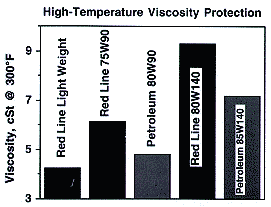
IMPROVED LOW TEMPERATURE FLUIDITY
Cold weather can be just as damaging to differentials and transmissions as sustained high-temperature use. Rapid oil flow to the bearings and adequate lubricant splashed to the gear teeth is critical to prevent component fatigue and premature failure. At -15ºF an SAE 90 gear oil will take more than 5 minutes to flow to the bearings while Red Line 75W90 requires only a second. This dry lubrication can cause rapid fatigue damage. High viscosities when cold will also rob the vehicle of considerable power until the lubricant has fully warmed up. Figure 2 below shows how Red Line Gear Oils compare to petroleum gear oils at OºC.
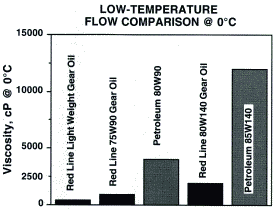
IMPROVED DRIVETRAIN EFFICIENCY
A combination of features of Red Line Gear Oils provides greater operating efficiency. Improved slipperiness in the gear tooth contact zone provides a significant friction reduction - improving power transfer and reducing temperatures. The relatively constant viscosity of Red Line Gear Oils compared to petroleums also provides a significant increase in efficiency. Figure 3 demonstrates how the low temperature viscosity feature provides a tremendous improvement in efficiency during short trip and low-speed service, yet even when the temperature has stabilized, a 2.5% efficiency improvement resulted from the replacement of the SAE 90 gear oil with the synthetic 75W90 in this European sedan.
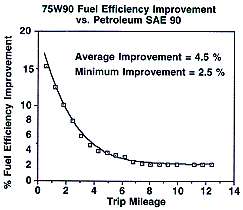 The ambient temperature during this test was 0ºC(32ºF) and both the transmission and differential lubricants were replaced with the 75W90. Even at stabilized temperatures or elevated temperatures resulting from heavy loads or high speeds, the higher viscosity at higher temperatures and improved slipperiness results in improved efficiency. Figure 4 below shows an axle efficiency evaluation comparing the synthetic gear oils to petroleum gear oils in a heavy-duty truck axle operated at its rated load. Red Line Gear Oils can provide a significant improvement in power transfer and fuel economy, while at the same time providing thicker oil films in the high-temperature contact zone which improves drivetrain durability. This feature has allowed Red Line to establish a reputation in auto racing as providing the best power and greatest equipment durability of any lubricants available. Red Line Gear Oils usually provide greater than twice the component durability in high-performance applications. These synthetics have demon- strated fuel economy savings as great as 5% in intercity freight hauling and between 0.5% - 3% in line haul trucking operations. The fuel savings alone provide a return many times greater than the cost of the synthetic lubricant.
The ambient temperature during this test was 0ºC(32ºF) and both the transmission and differential lubricants were replaced with the 75W90. Even at stabilized temperatures or elevated temperatures resulting from heavy loads or high speeds, the higher viscosity at higher temperatures and improved slipperiness results in improved efficiency. Figure 4 below shows an axle efficiency evaluation comparing the synthetic gear oils to petroleum gear oils in a heavy-duty truck axle operated at its rated load. Red Line Gear Oils can provide a significant improvement in power transfer and fuel economy, while at the same time providing thicker oil films in the high-temperature contact zone which improves drivetrain durability. This feature has allowed Red Line to establish a reputation in auto racing as providing the best power and greatest equipment durability of any lubricants available. Red Line Gear Oils usually provide greater than twice the component durability in high-performance applications. These synthetics have demon- strated fuel economy savings as great as 5% in intercity freight hauling and between 0.5% - 3% in line haul trucking operations. The fuel savings alone provide a return many times greater than the cost of the synthetic lubricant.
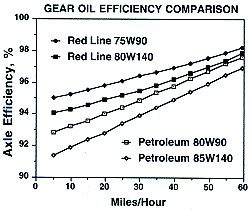
REDUCES TEMPERATURES
The enhanced lubricity and better heat transfer capability of the synthetics enables Red Line Gear Oils to reduce axle temperatures to insure a thicker oil film in the contact zone and provide better equipment durability. Red Line Gear Oils will reduce differential temperatures between 10 - 70ºF and transmission temperatures between 10 - 50ºF. The actual degree of temperature reduction depends on the speed and load conditions of the equipment - with more stressful conditions showing greater differences. Even greater temperature reductions can be seen when comparing axle break-in temperatures. The friction modifiers allow a more gradual wearing in of mating surfaces, significantly reducing break-in temperatures and minimizing potential problems associated with a loss of hardness of the gear tooth surfaces. Friction tests have shown Red Line Gear Oils provide a 15% reduction in the coefficient of friction compared to good synthetic and petroleum gear oils. Seal durability is another problem associated with high temperatures. Many seal materials will harden at temperatures above 250ºF, causing cracking and the leakage of fluid.
CORROSION PROTECTION
The extreme pressure chemistry used in many gear oils can be corrosive to brass and bronze used in synchronizers and bushings. Most gear oils are corrosive at temperatures of 200ºF. Red Line Gear Oils are non-corrosive up to 300ºF and the MTL in excess of 375ºF. A corrosive gear oil can shorten synchronizer life by half and can also contribute to rust problems.
THERMAL STABILITY
The thermally stable components used in Red Line Gear Oils insures stability even under elevated temperatures. Petroleum gear oils will form insoluble deposits which can interrupt the flow of oil to the bearings and gears, causing premature failure. These deposits can also be abrasive to the seals and cause leakage. Red Line Gear Oils are capable of being used many times longer than petroleum gear oils. These gear oils have been used in heavy-duty trucks for 250,000 miles with excellent cleanliness and durability.
SEAL AND LUBRICANT COMPATIBILITY
Red Line Gear Oils are designed to be compatible with seals which were designed for use with petroleum products. Reduced temperatures and improved deposit control should allow longer seal life. Red Line Gear Oils are compatible with petroleum and most other synthetics, so flushing is not required.
LIMITED-SLIP COMPATIBILITY
Red Line Gear Oils, with the exception of the 75W90NS, and 75W140NS, already contain friction modifier required for operation in limited-slip differentials. Additional additive is not usually required, but newer units or those with more lockup capability may require 1-4% additional Red Line Limited-Slip Friction Modifier. If Red Line is not available, the manufacturers recommended friciton modifier is compatible. Do not add addtional modifier unless necessary, as too much will result in excessive wheel spin. To perfectly tune a differential, start with the 75W90 NS or 75W140 NS and add the Red Line Limited-Slip Friciton Modifier until the limited-slip chattering just disappears.
PRODUCT APPLICATION
75W90 Gear Oil - the preferred product in nearly all car and light truck differentials, both conventional and lim- ited-slip. 75W90 is preferred for most racing applications.: It contains friction modifier which is recommended for limited-slip units. 75W90 Gear Oil can be used in many transmissions and transaxles; however, other Red Line lubricants have better frictional properties for rapid synchronization. Exceeds API GL-5.
75W90 NS, 75W140NS - GL-5 lubricants which do not contain the friction modifiers for limited-slip hypoid differentials. This makes the transmission synchronizers come to equal speeds more quickly, allowing faster shifting and much easier low-temperature shifting. Can also be used in racing limited-slip differentials where weak spring design causes too much wheel spin. These products provide significantly more lockup. Some Limited-Slip Friction Modifier may be required for optimum preformance.
80W140 Gear Oil - generally used in commercial trucks which will climb long, steep grades and some racing applications where power is not critical. Generally 0.5% less efficient than 75W90. Can also be used in differentials and transmissions where excessive noise is a problem and limited-slip differentials which vibrate excessively when turning a corner. Exceeds API GL-5.
LightWeight Gear Oil - a 75W/80W GL-5 gear oil designed to lubricate transmissions and transaxles which recommend 80W GL-5 gear oils. It has excellent low-temperature flow which allows easier shifting when cold. Also has good synchro compatibility. May be used to obtain maximum power transfer in racing differentials which do not see high temperatures.
SuperLight Gear Oil - a 70W/75W GL-5 gear oil with the viscosity of an ATF. This is used when temperatures are not high and when the maximum power output is required such as in qualifying laps.
ShockProof EP Gear Oil - a unique lubricant containing a suspension of solid microscopic particles as an extreme pressure agent. The viscosity characteristics allow the lubricant to resist throwoff and provide a film thickness greater than an SAE 250 grade, with the same low fluid friction as with the 75W90. Recommended for off-road racing and problem gearboxes. Also available in LightWeight and SuperLight viscosities.
MTL - Manual Transmission/Transaxle Lubricant. A 75W/80W GL-4 gear oil which is designed for manual transmissions which require 75W or 80W GL-4 gear oils, motor oils, or most special synchromesh fluids. It provides low temperature shiftability equal to an ATF, yet will not thin out or shear at high temperatures and provides the substantial gear protection of a GL-4 gear oil. The higher synchronizer coefficient of friction allows faster upshifting and downshifting and the lubricant is non-corrosive to synchros and bushings.
MT-90 - Manual Transmission/Transaxle Lubricant. A 75W90 GL-4 gear oil which is designed for manual transmissions which require 75W90, or 90 GL-4 gear oils or motor oils. Uses the same chemistry as MTL, but is a 90 WT in order to satisfy certain manufacturers which recommend SAE 90 GL-4 gear oils.
ATF - a full synthetic automatic transmission fluid which is a registered Dexron II, Mercon, and Mercedes-Benz 236.8 fluid and suitable for use in most automatic trans- missions. Its benefits include better thermal and oxidation stability which make it perfect for vehicles which see high temperatures. It also flows much better in low temperatures, providing tremendously improved shifting when cold.
D4 ATF - synthetic ATF for use where Dexron III or Mercon is recommended. A higher viscosity allows optimal operation at 40ºF higher temperature, providing better torque converter efficiency. Provides wear protection of a GL-4 gear oil. Perfect for all modern automatic and manual transmissions which call for Dexron III or Mercon ATFs. Superior stability allows high-tempera- ture operation without varnishing valves and clutches which causes failure. Provides the far better low-tem- perature operation compared to a conventional ATF.
HIGH-TEMP ATF - synthetic ATF for use where Dexron III or Mercon is recommended. A higher viscosity allows optimal operation at 70ºF higher temperature, providing better torque converter efficiency. Provides wear protection of a GL-4 gear oil. Perfect for heavily-loaded vehicles and automatic transaxles. Superior stability allows high-temperature operation without varnishing valves and clutches which causes failure. Provides the same low-temperature operation as with a conventional ATF.
RACING ATF - synthetic ATF for automatic and manual transmissions which need the positive shift of a TYPE-F ATF. This ATF contains no slipperiness additives, producing faster shifts and quicker lock-up. A higher viscosity at high temperatures provides greater torque converter efficiency and the enhanced extreme-pressure protection provides five-times the film-strength of petroleum and other synthetic ATFs.
DIFFERENTIALS - Red Line 75W90 Gear Oil provides excellent protection in nearly all differentials, conventional and limited-slip, in both racing and street use. 75W90NS and 75W140NS can be used in certain limited-slip units in racing to lock-up the differential. 80W140 should be used in commercial hauling, problem limited-slip units, racing applications which see tremendous torque at low speeds, and where noise deadening is desired. LightWeight or SuperLight can be used to obtain maximum power transfer in racing differentials which do not see high temperatures.
TRANSMISSIONS - MTL can be used in most manual transmissions and transaxles for both street and racing use unless the manufacturer requires the additional protection of an SAE 90 or the extreme-pressure protection of a GL-5. In those situations the MT-90 (GL-4) or 75W90NS (GL-5) will provide good shiftability and synchro compatibility and extra gear protection. LightWeight Gear Oil can be used in transmissions calling for a 75W or 80W GL-5. 75W140NS will provide greater high-temperature viscosity, reducing gear noise and rattle. D4 ATF can be used where the manufacturer calls for an ATF as the D4 has GL-4 gear protection and provides the best low-temperature shiftability.
Page last updated March 17, 2002.

 RED LINE SYNTHETIC GEAR OILS are designed to provide the highest degree of protection and greatest efficiency for your drivetrain. Red Line provides a com- plete line of drivetrain lubricants which are optimized for differential, transmission, or transaxle use over a wide range of temperatures. Proper selection depends upon the manufacturers' requirements and whether the application is for passenger automotive, commercial, or racing use. Red Line Gear Oils contain polyol ester base stocks, the only lubricants which can withstand the tremendous heat of modern jet engines, which makes our products provide excellent lubrication even under extreme conditions of high-loading and high-temperatures. The natural lubricity of the polyol esters provide excellent slipperiness which reduces the sliding friction in hypoid gears - reducing wear and significantly reducing temperatures. The synthetic basestocks have a natural multigrade property, so large amounts of unstable thickeners are not required to manufacture our gear oils, which means that Red Line Gear Oils will provide a stable viscosity for even extended periods of use. Red Line formulates more extreme-pressure protection into the gear oils than other petroleum and synthetic manufacturers which provides wear protection over a wider range of temperatures and performance conditions - ranging from high-torque and low-speed situations to very high-speed conditions with shock loading. Red Line also manufactures gear oils which can be used in limited-slip differentials without the use of additional friction modifiers.
RED LINE SYNTHETIC GEAR OILS are designed to provide the highest degree of protection and greatest efficiency for your drivetrain. Red Line provides a com- plete line of drivetrain lubricants which are optimized for differential, transmission, or transaxle use over a wide range of temperatures. Proper selection depends upon the manufacturers' requirements and whether the application is for passenger automotive, commercial, or racing use. Red Line Gear Oils contain polyol ester base stocks, the only lubricants which can withstand the tremendous heat of modern jet engines, which makes our products provide excellent lubrication even under extreme conditions of high-loading and high-temperatures. The natural lubricity of the polyol esters provide excellent slipperiness which reduces the sliding friction in hypoid gears - reducing wear and significantly reducing temperatures. The synthetic basestocks have a natural multigrade property, so large amounts of unstable thickeners are not required to manufacture our gear oils, which means that Red Line Gear Oils will provide a stable viscosity for even extended periods of use. Red Line formulates more extreme-pressure protection into the gear oils than other petroleum and synthetic manufacturers which provides wear protection over a wider range of temperatures and performance conditions - ranging from high-torque and low-speed situations to very high-speed conditions with shock loading. Red Line also manufactures gear oils which can be used in limited-slip differentials without the use of additional friction modifiers.



